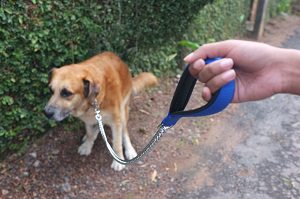7 Essential Commands for Your Dog to Learn Now
July 12, 2017
Trina
One of the first questions to cross a new dog owner’s mind is how to train your dog. I like to think of this process in two phases. First, and most critically, should be teaching your new pup the essential commands that will help keep him safe in most situations. Second, and this is the fun part, teaching your dog the tricks that both he and your family will enjoy. Something that too often goes unsaid is that training can be a valuable bonding experience between a dog and his humans. As such, it is hugely important that all members of the family take part in the training. Whether in a teaching or reinforcing role, participating in training these common dog commands serves as a critical building block of respect and love between you and your dog.
The 7 Most Common Dog Commands are….
- Sit
- Stay
- Come
- Drop It
- Heel
- Play Dead
- Roll Over
Let’s cover the essential commands that will safeguard your best friend in many potentially dangerous scenarios. Your very first training effort should always be to teach a dog to sit, stay and come. Yes, these are three distinct commands, but most trainers will tell you that they should be taught in unison. They will also almost unanimously tell you that teaching a puppy to stay is the most important lesson he’ll ever learn. Other valuable steps in proactively protecting your puppy, are teaching him to drop it and learning to heel your dog.
Often some of the traits that we treasure most in our dogs can be the same behaviors that put them at risk in certain situations. Imagine you’re arriving home from work and your pup is watching over your children in the park across the street. As soon as you come into his view, all he knows is that another one of his favorite people has returned from the most recent unbearably long absence. He’ll want to smell where you’ve been and to tell you all about his day. While you’re obviously excited to see him as well, what you notice and he doesn’t, is that your neighbor is arriving home as well and can’t hear you with the windows up. In that instant it is invaluable to know that no matter what else is occupying his attention as he nears the street, your command to sit and stay will break through and result in him immediately complying and possibly saving himself from unthinkable harm.
Close relatives to the sit and stay commands are come and heel. Again, one of the things we love most about our dogs is their unbridled enthusiasm for all things fun. Unfortunately, at times those things can lure our furry friends into an impromptu chase. Before you know it, he’s a football field away from you in some dense brush. In this situation, it sure is nice to know that even though he can’t see you, he’ll still hear your voice and come trotting when asked. Heeling may not be the most important of commands related to safety, but the skill is a valuable social tool. As shocking as this may seem to you and me, not everyone is comfortable around dogs. When encountering one of these unfortunate souls during a walk, the ability to heel your dog benefits everyone.
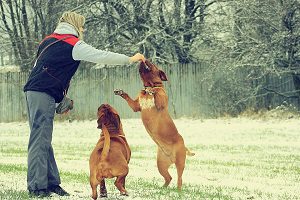
Bringing a close to safety commands, you’re also going to need to teach him to drop it when requested. Again, our best buddy’s enthusiasm (and relentless desire to chew), can put him in a vulnerable spot. There may come a time when he has trouble discerning between a new toy and a prescription bottle that was inadvertently knocked off the kitchen counter. You’ll sleep better knowing that if this sort of quandary ever presents itself, both you and your dog are prepared.
Now that we have the essential commands out of the way, you can begin teaching some of the more advanced dog tricks everyone loves. The possibilities here are limited only by you and your dog’s imagination, but some good building blocks are teaching a dog to play dead and roll over. These are fun tricks he can impress his friends with while proving useful to you at the same time. Cleaning your boy’s ears can be a challenge as it clearly won’t be one of his favorite activities. Having mastered these two commands can make that task easier on both of you.
Try not to look at training as a task so much as to view it as an opportunity to protect your new family member, while at the same time bringing him closer together with his new family. You’ll all be happier for the experience, the results and the memories!
Read more like this:
AdviceHow to Potty Train Your Puppy
May 10, 2017
Craig
Figuring out how to potty train your dog fast isn’t easy and will require some hard work. While it can appear to be a daunting and arduous task, potty training a puppy can be manageable with persistence and consistency. You’ll find that establishing a routine is key when learning how to potty train a dog fast. You just have to remember that the routine you set in the beginning stages is the key to training success, saving you from a grim future of cleaning up their soiled messes on your indoor flooring time and time again.
There are multiple methods teaching you how to potty train a puppy. Two of the most popular are crate training and outside training. We will explore both in depth so you can determine what will work best for you and your puppy.
Crate Training
Experts suggest that you begin potty training your puppy between 12 and 16 weeks of age. At this age, he will have enough bladder control to begin a routine. When crate training, choose a crate that is large enough for your puppy to turn around, stand and lie down in. Note that a crate which is too large will allow the puppy to use the bathroom on one side, while still keeping his bedding area clean on the other side. This will hinder the training process and the association to go to the potty outside, not in the crate or your home.
The crate should be a welcoming environment, padded with a blanket and maybe a toy or two. You want your puppy to enjoy his crate time. In the beginning, bring your puppy to his crated area during times of rest for short intervals, starting with about 15 minutes and increasing from there as he gets older. After the allotted time is up, take your puppy out of the crate and bring him outside to use the bathroom. The key is for him to realize that after crate time comes potty time. Once he does use the bathroom, heap on the praise and feel free to reward him with a treat. Repeat this routine consistently throughout the day.
In the evenings, make sure to remove his water source about 2.5 hours before his bedtime. Take him out one last time before bed. Remember that you’ll have to take him out to use the bathroom again during the night if he wakes up. This is to ensure he doesn’t have an accident in the crate during those nighttime hours. After a few months, he should be able to have enough control of his bladder to make it through the night.
Outside Training
Just like crate training, establishing a routine is essential for potty training your puppy outside. In the early stages of training, it’s best to take your puppy outdoors frequently. At least once an hour will ensure you are setting your puppy up for success. Don’t forget to take your puppy outside when he wakes up from sleeping and after playing, eating, and drinking.
Set up an eating schedule for your puppy and pay attention to any signs he needs to go after he is done. Regardless, he should be taken out immediately after his meal even if he doesn’t show any obvious signs of having to go. Every dog is different, so it may take multiple trips outside before you can figure out how to house train a puppy. You will need to be vigilant to determine how soon he needs to use the bathroom after eating. Again, remove his water source 2.5 hours before bedtime and pay attention if he wakes up during the night, taking him out right away if he does.
When taking your puppy outside, pick a location for him to use as his potty and stick with that same area every time. Once he goes, praise and reward him for his efforts immediately after he is done so he can associate what he has done with the positive attention you’re giving him.
With both crate training and outside training, don’t expect your puppy to be perfect after the first day, week or even month. Expect mistakes and when they do happen, clean up the mess without complaint. If you catch your puppy starting to go, pick him up quickly and take him outside. Punishing a dog after the fact is useless and will only result in a confused look as they can’t connect the fact they’re being disciplined with their natural need to potty.
With some patience, consistency and lots of love and praise, you can be sure you’ll be well on your way to house training your puppy fast. Keeping in mind that building a trusting relationship will also enable you to quickly master how to successfully potty train your puppy. Stick with it, have patience and all your efforts will quickly be rewarded.
Read more like this:
AdviceHow to Spot When Something Is Wrong with Your Dog
March 8, 2017
Trina
On average, your dog will probably live for about 10 to 13 years. Although that sounds short, it is roughly equivalent to 91 human years! Now, that sounds amazing. But there’s something you need to remember: just like humans, the older they get, the more likely it is that they are going to get sick. In fact, many dogs are born with genetic risk factors and congenital defects which become more evident as they age. Unfortunately, your dog cannot speak your language, so you need to be aware enough to recognize when they are not feeling well. Hopefully, this article will provide you with the information you need to spot common signs and symptoms before they get worse. 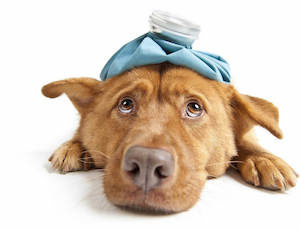
“What’s Wrong with My Dog?”
Before we get into the signs and symptoms, let’s talk about the reasons why your dog might fall prey to certain illnesses in the first place. A dog can suffer from a disease for a variety of reasons, but these are the most common ones:
- Genetic Risks – Dogs have a pretty long history, and over time, as they were interbred, and changed environments (shih tzus being taken from China, huskies now living in Florida, etc), many dogs today developed genetic predispositions which can manifest as increased risks for certain diseases.
These risks depend on the breed. Some examples of dog health issues by breed include eye problems for pugs, cancer for boxers, autoimmune disorders for huskies, and respiratory problems for bulldogs. Keep in mind that having these risks doesn’t mean your dog is already sick or is guaranteed to develop these problems. Some dogs never develop any health problems at all and they die due to old age. These risks simply mean they can develop a certain kind of disease much earlier than the general population.
- Food – Nutrition is just as important for dogs as it is for humans, and their diet should be complete and balanced,. While there is much debate over diet, it doesn’t matter whether you’re feeding your dog food that is raw or cooked, canned or dry, as long as it’s always a nutritious meal for him. Additionally a dog may require a special kind of diet if he is diagnosed with certain conditions such as obesity or arthritis.
- Infection – Dogs can catch illnesses from other pooches too. A great example of this is distemper, which is a neurological condition caused by an airborne virus. It is almost always fatal for pups and for dogs which have never been vaccinated.
- Changes in environment – Do you know your dog can become depressed ? Your dog can become sick when there’s a new addition to the family, from stress, the presence of other people / strangers, and even routine changes (e.g., making your dog sleep outside, instead of inside, your room).
Common Dog Health Symptoms
The kinds of dog health symptoms vary according to the specific disease, but there are general symptoms that may warrant a visit to the vet as soon as possible:
- Fatigue – Are you telling yourself, “My dog is lethargic and not himself”? If so, there’s a good chance your dog is sick. To be clear, dogs can get tired because of too much play or exercise. If you’re not feeding your dog well, he will also become weak. However, if his fatigue lasts for the whole day and your dog hardly ever eats or drinks, it’s time for a vet visit.
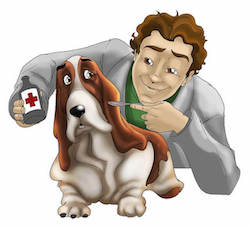
- Change in behavior – Dogs do have personality traits, but if your dogs behavior changes suddenly, t could be because it is suffering from certain health problems. An example is if he becomes passive or aggressive, especially if you cannot determine a potential reason. Note: Changes in behavior may be a symptom of a disease or an effect of the illness. For example, dogs with rabies are known to bite. On the other hand, a feeling of general unwellness may force your dog to withdraw or isolate itself.
- Diarrhea – What’s a healthy poop for dogs? Refer to this chart. If the stool is soft, loose, or watery, and if it lasts for 24 hours, it’s possible your dog has diarrhea. This symptom can be sudden or chronic, depending on the cause. Either way, because it can lead to dehydration, have your pooch checked right away.
- Changes in physical appearance – Does your dog appear to be limping? Does he have red or watery eyes? Can you spot lumps? Does his coat appear less shiny than it used to be? How about his mouth? Are there changes on his teeth?
This list of dog health symptoms isn’t meant to cause panic or worry. Not all of these symptoms may mean an illness, and not all diseases require a veterinary hospitalization. Often at-home treatment will do. Knowing this list and keeping it in mind will help you be a better pet parent.
The sooner you catch the the onset of a disease or illness, the less likely your dog will require extensive care. Most importantly, your dog cannot depend on anyone else they way they can depend on you – you have the opportunity to provide your beloved furbaby the great life it deserves, simply by being aware of any potential health problems and making sure he has the care he needs, when he needs it.
Read more like this:
AdviceWhat to Do When Your Dog Won’t Stop Chewing
February 8, 2017
Craig
You love your dog but you also loved your shoes and your gym bag and your furniture, all of which some some distinctive doggie teeth marks in them now. You’ve googled furiously but can’t bring yourself to lock your dog in a cage all day while you’re at work spray all of your belongings with cayenne spray, only to end up cleaning up vomit. Don’t worry. There are ways to cure your dog of his chewing habit in a safe and humane way once you understand what is causing the chewing.
Generally a dog will chew for one of the following reasons: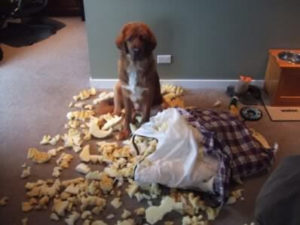
- He’s a puppy and don’t know any better.
- He’s bored.
- He’s scared.
- He has separation anxiety or is sick
- He has excess energy
He’s a puppy and doesn’t know any better
If the problem is that your dog is a puppy and simply doesn’t know any better, the solution is easy: teach him not to chew. You can do this by giving him a chew toy instead. When your dog is a puppy, it’s your responsibility to teach him what he can chew on and what he can’t by replacing things he shouldn’t chew on with things he can and by praising him when he chooses the appropriate chew toy.
As a puppy, he may also be teething and chewing on your favorite shoes or sofa in an effort to relieve the pressure in his gums. If that is the case, giving him a frozen wet washcloth to chew on will bring him pain relief and protect everything else. Make sure when you do this to supervise him so he doesn’t accidentally swallow any parts of the washcloth.
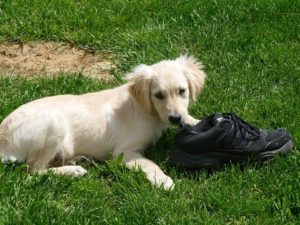 He’s bored
He’s bored
You’re busy at work all day but he’s sitting around your house, wondering when his best friend – you- is going to come home and play with him or take him for a walk. Your dog doesn’t have the ability to amuse himself with a book or tv show so those long, lonely hours are really boring. You can help alleviate this boredom by scheduling more frequent walks with a dog walker or play dates with other dogs. If you’re interested in socializing your dog with other animals and allowing him off-leash playtime, you should check out our off leash dog walking services.
He’s scared
There might be something in your home environment which terrifies your dog. It could be separation anxiety or noises like fireworks or a thunderstorm which is stressing out your dog. To self-soothe, he turns to chewing, much as many of us turn to comfort eating. While there isn’t much you can do about a thunderstorm or fireworks, you can help your dog by creating a safe space for him in your home. Make his dog bed extra cosy and be sure to keep a favorite stuffed animal and chew toy there so he has a better self-soothing option than to nibble on your shoes to feel close to you and comforted.
He is sick
If your dog is sick the best thing you can do is to consult a veterinarian. Your dog could be sick or simply suffering from nutritional deficiencies, which can lead to pica. Gastrointestinal problems can also cause a dog to chew as a coping mechanism. If your dog is chewing at an age when it’s no longer developmentally appropriate, make sure to take him to the veterinarian to rule out any mental or physical health issues.
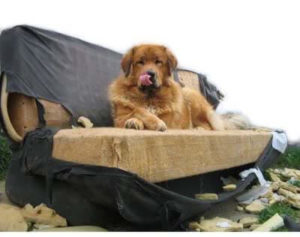 He has excess energy
He has excess energy
Make sure your dog is getting enough love and attention, ideally both from people and other dogs. By taking him on lots of walks, you’ll be reinforcing your bond and getting some exercise yourself. Just like a human, an exhausted dog is more likely to be better behaved. If you keep your dog active, he might be too tired to expend the additional energy on chewing up your things.
And remember…
No matter what, don’t scold your dog or punish him after the fact. Dogs don’t have the same sort of long-term memory that humans do and won’t be able to associate the scolding or punishment with his earlier misbehavior. Instead, he’ll assume he’s being punished for his current actions and you may be accidentally training him out of good behaviors.
Read more like this:
AdviceIs Co-Sleeping Safe for Your Dog?
February 3, 2017
Trina
Commuting time in the Bay Area is getting worse, so finally being able to rest and sleep on your plush bed is heaven. If you’re a pet parent, it becomes even better when your dog starts to snuggle close to you. Nothing beats having your furry baby in the warmth of your arms. But do you know there’s a heated debate happening over co-sleeping with your dog? Not everyone approves it for variety of reasons. The purpose of this article is not to stop you from doing it but to help you make the right choice not only for yourself but also for your pet.
The Benefits and Risks of Co-Sleeping with a Dog
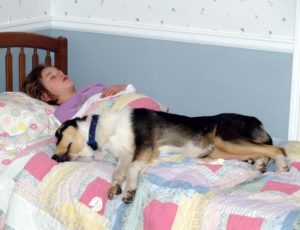
Why do pet parents like you allow dogs to sleep in your room and your bed? Here are some possible reasons:
- Personal security – Let’s face it, everybody wants to be cuddled, hugged, and feel loved. In fact, it doesn’t matter where we get it! Dogs can give these things to us – and more. Dogs are alert. They are more likely to be the first ones to know if there are intruders (knock on wood). If you have a medical condition, dogs can be trained to sense symptoms then wake you up or even to fetch your medicines.
- Lack of space – Although many landlords do not allow pets, especially if space is tight, some do. But this also means sharing whatever space available, including your bed, with your dog.
- Behavioral issues – Some dogs feel depressed when you’re not around. They may also be showing signs of emotional trauma, which is common among rescued pets. Either way, as a responsible pet parent, you want to make them feel safe and loved, so you want them to be as close to you as possible.
It sounds like co-sleeping isn’t bad at all! Well, let’s look at the other side of the coin, shall we?
Why should you consider training a dog to sleep alone?
- Behavioral issues – Dogs have different temperaments, and their breed only partly defines how they behave in the bed. Dogs can vomit, snore, fart, jump, and scratch. They can occupy your entire bed (this is called dog sleeping in bed dominance). Your pooches, sadly, can show signs of aggression when you try to invade their space.
- Poor sleeping patterns – Some studies show co-sleeping with dogs doesn’t interrupt your sleep while others say it does. Again, it’s a debate. However, if your dog has the issues I mentioned a moment ago, you can’t really expect to have a good night’s sleep. In addition, you do not control your dog’s sleeping habits. They can wake up in the middle of the night or early in the morning when you’re still in dreamland.
- Medical conditions – Some people are allergic to dogs, but they don’t need allergy shots or the condition is manageably mild. Nevertheless, to control attacks, it’s best to keep any dogs out of your room. You may also consider learning how to stop dog sleeping in bed with you if you’re worried about getting these rare but serious diseases.
- Babies – Should you consider co-sleeping with a dog AND a baby? If you ask the message boards for moms, the crowd is divided. But know there are risks including your baby being accidentally smothered or squished, your baby catching certain illnesses, or dealing with jealousy issues.
How to Train a Dog to Sleep Alone
- Claim your position as the leader of the pack. Unless you establish this, you’ll never learn to teach the dog how to sleep in his bed and outside of the bedroom. A good way is to correct your pooch when it starts to become aggressive, unruly, or disobedient.
- Don’t expect to accomplish your goal overnight. Do you know there’s a thing called dog sleeping in bed separation anxiety? Yup, your dog might feel sad when it’s kicked out of the room. You, therefore, have to be firm but gentle and loving with your approach. You can begin by introducing the dog to his bed (here’s a guide on how to choose the best dog bed). Put him on a leash, guide him to his bed which should be placed in a room other than the bedroom, and say, “Go to your bed.” Once he reaches the bed, say “Stay” or “Sit.” If your dog performs the command, give him a reward. Repeat the process a couple of times during the day until he can understand the “Go to your bed” command.
Another way:
The goal of the exercise above is to help your dog sleep outside the bedroom. But in case you want your dog to be inside your room, you can learn how to train your dog to sleep with you. Once Fido is already familiar with its bed and understands the command, you can now bring the bed inside your room. Place it in a corner where your dog can still see you.
Is co-sleeping with your dog okay? The truth is there’s no magical formula on how to build a good relationship with your pet. Sometimes it works and sometimes it doesn’t. I’d say do whatever it is that works for both of you. It’s essential you and the dog are happy and secure. But as the pet parent, never forget to establish dominance and rules to make sure your dog doesn’t invade the personal space you want and that you’re getting the sleep your body needs for the next day.
Read more like this:
AdviceHow to Train Your Dog Not to Bite
January 27, 2017
Trina
In San Francisco, there are no official statistics on the annual number of dog bites, but on the average, there were more than 250 people bitten by dogs in 2014. That may not seem like a lot, but some experts believe the number is increasing. Whether dog bite numbers are increasing or decreasing, you do not want your dog to be a biter a variety of reasons. First on the list is the fact you can endanger your own life or that of your loved ones or a stranger. Just look at the jaws of large breeds! And even if they’re not big, a small dogs jaw can still pack a punch.
The Biggest Problems with Dog Bites 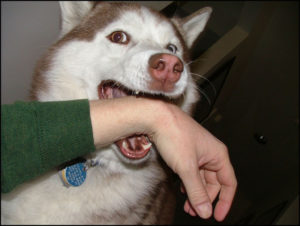
Dogs can kill. We just have to remember the story of Diane Whipple who was attacked by two dogs in the hallway of her apartment building. The dogs caused over 70 injuries all over her body, leading to a massive loss of blood.
Due to this possibility, states and cities take dog bites very seriously. In San Francisco, you can be sued in civil court for financial and emotional damages which can cost you thousands of dollars. In Whipple’s case, the court convicted the dogs’ caretaker from 15 years to life.
You also have to keep in mind the welfare of your dog. Many of the dogs which bite are considered to be dangerous to society and are often put down.
Train Them Not to Bite
Whether it’s for play or a show of aggression, dogs can – and will – bite. As the dog owner, you must train your pooch on how to control or avoid it altogether.
Here are a few pointers:
-
During Play
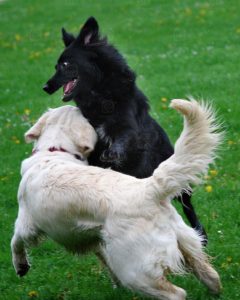
Non-aggressive dogs tend to bite when they are playing. In fact, it’s perfectly normal for them to do so, but that doesn’t mean it’s something you should tolerate.
One of the first techniques is to bring their attention to some object other than your hand, foot, or dress. For example, if your dog starts opening its mouth, ready to take a bite, hand it a toy or try to play catch.
What if your dog happens to bite your hand before you can do anything? It’s important you don’t move your hand to avoid potential lacerations or more serious injuries. Moreover, you don’t want to give your dog the idea that this is part of the play. Keep your hand steady and wait for your dog to let go before you offer them the toy.
Another way is to tell your dog straightaway you don’t appreciate the rough play. When your dog bites, make a yelping sound or say “Ouch!” That will hopefully calm your dog and trigger it to pull away from your hand. Then ignore your dog for a few seconds just to let it know you don’t tolerate such behavior.
-
When You’re Out of the House
Most dog bites happen outside the house in places like your yard, on the street, or in a dog park. To train a dog not to bite, consider:
- Putting your dog on a leash. (Suggestion: use a harness rather than a collar to reduce the chances of putting pressure on your dog’s neck.)
- Learn to be the alpha. This means you should always be beside, not behind, your dog.
- When your dog starts to pull away from you and attack another dog or person, pull the leash to catch its attention.
- Learn the commands of sit and stay. This will help you communicate with your dog that they shouldn’t be doing what they’re doing (being aggressive)
- Redirect your dog’s excess energy (if this is the cause of biting) to an off-leash dog park or dog camp
- Create off-limits areas and set up dog gates or fences, especially in places where foot traffic is high.
- Hire a professional dog walker who has experience dealing with dogs who bite
Tip: Some dog owners would keep their pooches inside when they’re too afraid their dogs might bite, but this can be counterproductive. Dogs may channel their built-up energy with biting.
-
Other Tips

- Understand the dog’s backstory. This is especially true when you have a rescue dog. Many of them were abused, and biting is their way of coping with the fear or protecting themselves from potential threats.
- Hire a trainer. You can use various online courses and materials to help you train your dog, but having a professional trainer is generally better. It saves you time, and the chances of success are high.
- Bring your dog to the doctor. It’s possible the biting is related to illnesses or even depression.
No matter which strategy or combination of strategies you choose to pursue, please remember if your dog is a natural biter, you should not expect it to change its behavior overnight. It may take weeks or even months before you can teach your dog not to bite. As a dog owner, you need to extend your patience for as long as you can. There will be many moments of frustration and disappointment, but do not despair. Whether you believe it or not, dogs don’t give up on us. At the time when they need our help, it’s time that we do the same.
Read more like this:
AdviceUnderstanding Why Dogs Bite & How Serious the Bite Can Be
January 23, 2017
Trina
In San Francisco, more people are raising dogs – that can be both a good and a bad thing. With a population of overworked people, having a pet is one of the best ways to reduce stress. Moreover, with proper training, dogs are easy to maintain and capable of looking after themselves when left alone for hours. However, dogs can bite, and biting is a matter taken seriously in the city. Whether you think your pooch is nice doesn’t matter. You can still be held liable under the city’s civil law.
Nowadays you can implement many methods for dog bite prevention, but if you don’t get to the cause of the problem, all you’ll be doing is trial and error. It’s going to be a waste of time, money, and effort while subjecting both you and your dog to frustration. In other words, you have to learn the whys and hows in order to really be successful.
Why Do Dogs Bite?
Many people say “Not all dogs bite.” That’s partly true since I have met pooches that are incredibly easy to approach and even cuddle. We can have a cuddle fest for hours! That’s how meek they are. On the other hand, I’ve come across dogs you should never provoke if you don’t want a swollen hand as a souvenir of the interaction.
But here’s the truth: all dogs bite. In fact, all animals with teeth are capable of biting. It’s just that dogs bite for a variety of reasons, and these may explain why some are meek, others not.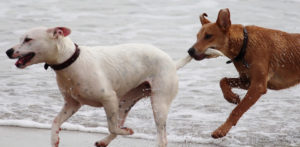
Why do dogs bite?
- They like to play – Dog biting for play is normal. The problem begins when they start biting anything or, worse, anyone, without discrimination. The bite can be mild to severe, which happens when the dog is frustrated and/or stressed about something. These emotions can make them more aggressive.
- They feel threatened – Do you know what happens to your body when you’re under stress? It goes into a fight-or-flight mode, which explains why your heart rate and cortisol levels go up and your body releases stress hormones like adrenaline. They help prepare you to either run or face your enemy to survive. It’s the same thing with dogs, although they often deal with the feelings of stress, threat, and fear through biting.
- They are sick – Oh, if only dogs could talk, then we would know what they are feeling every single day. If they’re not feeling well, dogs would probably like to tell you what’s wrong in human language so that you can act immediately, but since they can’t, they resort to biting.
- They are depressed – Yes, dogs can be sad and depressed for a lot of reasons, including missing you. Dog depression symptoms are also not very different from human depression symptoms: withdrawal, lack of appetite, and changes in behavior, which means they can either be quieter or more aggressive than usual.
How Do Dogs Bite?
There’s no official classification for dog bites, but Dr. Ian Dunbar developed levels. I highly suggest you read it. To give you an idea, a dog bite may be:
- Level 1 – Also called a pre-bite, it means the dog is already showing teeth, but they don’t come into contact with the skin. It could be because you’ve already pulled your hand away, and the dog doesn’t proceed with biting.
- Level 2 – This is when the dog’s teeth hit the skin, but there’s no bite.
- Level 3 – Levels 3 to 6 already indicate a bite, but they differ regarding the number and depth of the punctures. In level 3a, the puncture is shallower than canine tooth. Level 3b means there are multiple shallow punctures.
- Level 4 – This level should tell you the bite is already serious it may even need an emergency room visit. The puncture is deep as the dog clamps down teeth into your skin. Worse, the victim can develop lacerations, which indicate the dog was moving its head while biting – the bite is showing signs of moderate to severe aggression.
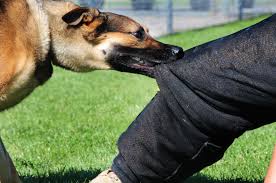
- Level 5 – The dog doesn’t just bite the victim hard once. It does so multiple times.
- Level 6 – The dog’s bite kills the victim.
Why are these levels important? A lot of people tend to believe that small dogs equal small bites, so they are less harmful. While some bites may be easier to treat, all bites can still cause injuries and, more often than not, trauma.
All the information you read here plays a significant role in creating your dog prevention strategies and training. First, you need to understand the reasons behind the bite. If it is because of play, you may want to redirect the dog’s energy to something else to prevent biting. Is the dog scared? Removing the stressor can prevent aggression. Then you need to evaluate the kind of bite the dog makes. Note there is no such thing as an ignorable bite. Nevertheless, it should give you or the trainer an idea about the duration, kind, and approach to aggression training. Either way, control biting early and enjoy a more harmonious relationship with your pooch.
Read more like this:
Advice
